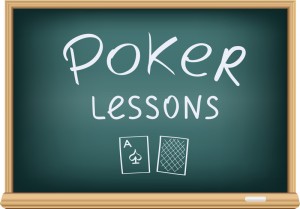The expertise involved with calculating odds, surmising hand strength with incomplete information, negotiating with bluffers, and staying within a bankroll all offer lessons that my daughters will eventually learn to apply to other aspects of their life journeys. In this world, I think those are especially valuable lessons and applications for women to have learned. Sometimes, as I attempt to continue the lessons the next day, I get some valuable insight into how play is perceived and how positive attributes are sometimes applied mistakenly to our opponents.
I recently hosted my regular Friday home poker game. As is typical, I started an hour early for anyone who was willing to sit with my daughters before they go to bed to the sounds of chip splashing and explosive river beats. I stake them each for $5 (blinds are .25 and .50 in our no-limit game) and they get to keep any profit after one hour. I eat the losses and they leave the table if their stake is gone. While Emmie left the table after handing me her remaining 75 cents, Gabby paid off her stake and headed up to her piggy bank with $39 in profit (yes, that’s 78BB for an hour’s worth of table time).
Her biggest hand went something like this: Gabby limped into the pot from middle position and saw a flop of K-K-x with three others. The player UTG checked to Gabby who then bet $1. It folded around back to UTG who check-raised Gabby for $3. She answered the raise and her opponent again checked to the blank that fell on the turn. Gabby bet another dollar only to get another check-raise from UTG. Again she answered the two dollars. The river brought a Q and this time UTG led out for the $3. Gabby raised him to $5, he answered, and she turned over QQ for the full house to beat his trip Kings. She sucked out good and the table erupted.
After Gabby left the table, the talk turned to her “fearlessness” and “gutsy bets”. I’m warned that I’ll need to keep an eye on this one as she gets old enough to find herself stuck for more than the $40 she took tonight. I quietly agree and start wondering how I’ll approach the hand history in the morning along with the lesson on not celebrating the highs too hard or over-thinking the lows too long. Given that Emmie only got to see one flop with her dismal hands, we also had a great discussion opportunity on the differences in action for one session of cards.
A few guys asked if Gabby really knows what she’s doing. I indicated that both of my daughters know what a strong hand is, but probably don’t know how to read their opponents very well. In fact, they pretty much just play their cards. In addition to that, Gabby is able to bluff and can disguise those bluffs pretty well.
But allow me to focus on the hand history discussion. The next morning, I asked Gabby to tell me what she recalled from the hand. Much like the answers I get to “how was school today”, I got a short response that lacked any depth whatsoever.
– I dunno.
– Well, Gabby I continued. What did you think he was playing?
– I don’t know she responded. I just saw that I had two Queens and I thought they made a good hand.
– Do you remember what he turned over? I asked.
– He had three Kings.
– Didn’t you think you were beat when he kept raising you?
– I guess so, but I didn’t want to get rid of two Queens.
I asked Gabby how many of the hands that she won were won with an outright bluff and she recalled that two or three of them were bluffs.
Gabby’s “table image”, if you will, was that of fearless, gutsy, and unpredictable. I’m not so certain she would have been classified as a maniac, but definitely hard to put on a hand. It is important to distinguish, however, that she was actually a player who saw only her hands. Gabby can bet her hands according to their perceived strength, but she still does so within a bit of a knowledge vacuum and certainly without enough regard for what her opponents might hold (as evidenced by calling check-raises against an obvious third King).
A few big wins, a large chip stack, and one noteworthy suck-out encouraged the table to attribute all kinds of image that wasn’t necessarily accurate for Gabby. Furthermore, she was approaching the game like many of the on-line opponents I see at tables as high as the $200 ($2/$4 blinds) no-limit tables and the $5/$10 limit tables. Like Gabby, many of these players are focused more on their cards and the stand-alone strength of those cards, often unwilling to let go of big cards to inappropriate flops. These are players to whom I apply notes based on the chip stack with which I regularly see them sitting as well as the cards they either show down or willingly expose. This is limited information at best.
Software like Poker Tracker also allows us to gather information about our opponents and conveniently packages their image into nice little icons and labels. Granted, this information is much more quantified and objective than my player notes on each site, but to what degree do we overvalue these markers? Certainly, when we’re looking at a hand like AQ out of position and our only opponent is recorded as seeing the flop more than 60% of the time, we’re going to have some information that informs our ultimate decision. Nonetheless, I still find value in my conversation with Gabby on the morning after the game. We so often scratch our heads and wonder just how these opponents can play the hands they play despite the obvious strength we’re indicating with our bets. This gets especially exhausting and vexing when they land their two-outer on the river and take a huge pot that was rightfully ours. Sometimes the answer is glaringly simple.
I don’t know she responded. I just saw that I had two Queens and I thought they were a good hand.
Play well.
Troy Headrick
Submit your review | |



